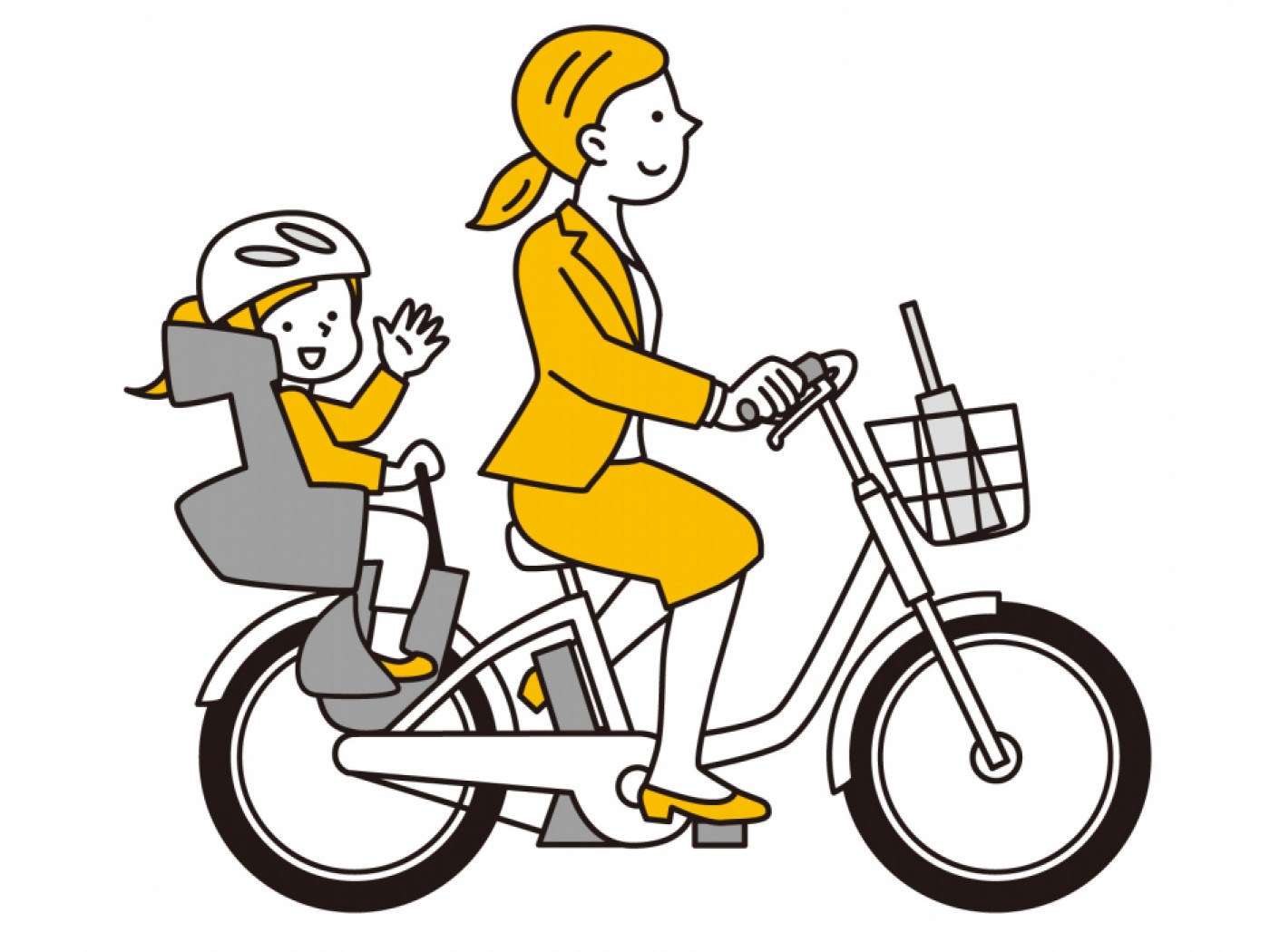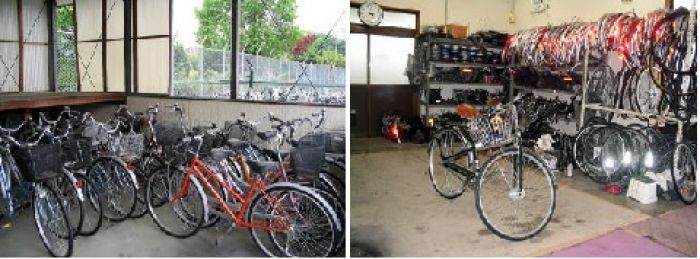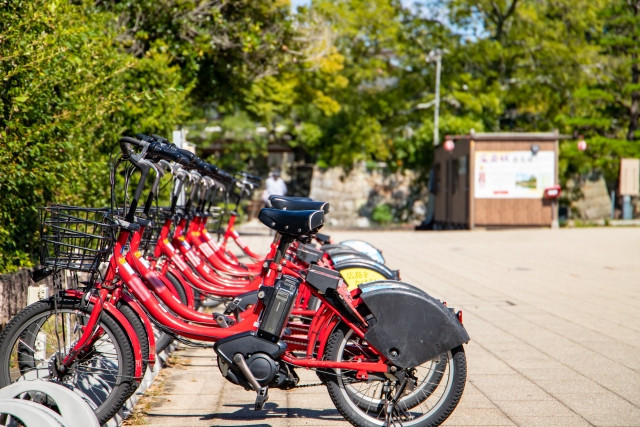In this article, we explain all there is to know about owning a bicycle and cycling in Japan, plus bike owner responsibilities like bicycle registration for anti-theft measures and insurance for accidents. We also introduce other alternatives like rental bikes and bike-sharing services in Japan. Plus, it’s always important to know the traffic rules when cycling in a foreign country.
Table of Contents
- Cycling in Japan
- Buying A Bicycle in Japan, Owner’s Manual
- Bike Rentals and Bike Sharing Systems in Japan
- Cycling Rules and Regulations
- Takeaway
Cycling in Japan, A Common Mode of Transportation

Cycling is one of most widely used modes of transportation in Japan besides taking the train and walking in cities, and driving a car in the countryside. From children to senior citizens, housewives to salarymen, you can find people of all walks of life using bicycles to reach their destinations.
According to a study conducted by the Japanese Ministry of Land, Infrastructure, Transport and Tourism (MLIT) on the usage of bicycles in Japan, in 2019, there were 67,616,000 bicycles owned in Japan.
※ MILT, “自転車の活用に関する現状について” Pg. 2
Commuting by Bicycle

Cycling is a feasible option for people who live near their workplace or school. For students and workers whose companies don’t cover commute expenses, travelling by bicycle may even save you money in the long run. There are also some people who cycle to their nearest train station, park at a bicycle parking lot, then take the train to work.
According to the bicycle survey conducted by MILT, 12% of Japanese residents nationwide use bicycles as their primary mode of transportation. And an additional 1% use bicycles to commute to their nearest train station. Osaka City has the largest number of bicycle commuters with 28% of work and school commuters opting to use bicycles.
The study also notes that there has been a marked increase of bicycle commuters since the Coronavirus outbreak. With a sample survey group of 500 Tokyo residents that commute to work by bicycle, it was discovered that 1 in 4 of them have switched to bicycle commute since the Coronavirus outbreak. When asked “Why did you switch to bicycle?” 95.7% of respondents answered that they did so to avoid using public transportation.
Do note that if you do choose to commute by cycling, you might need to inform your workplace (insurance related issues) or school (safety related issues).
※ MILT, “自転車の活用に関する現状について” Pg. 3, 9
What is bicycle in Japanese?
The Japanese word for bicycle is「自転車 jitensha」. In English, we also call bicycles “bike” for short but 「バイク baiku」in Japanese taken from motorbike refers to motorbikes and motorcycles. This is a common source of confusion for many foreigners living in Japan when reading road signs including the word 「バイク」. For example,「バイク進行禁止 baiku shinkou kinshi」means “No Motorcycle Entry” and not “No Bicycle Entry”.
Bicycles are also called「ちゃりんこ charinko」, or chari for short. It is said that this term originated from the “ching ching” sound of bicycles’ bells. Another saying is that the word was taken from the Korean word for bicycle - “chajonggo”, and slowly developed into charinko over time.
What is “mamachari”?

Mamachari (ママチャリ) is the most common type of bicycle used in Japan. Mamachari means mom’s bike; mama (ママ) for mom and chari (チャリ) for bicycle as we mentioned right above.
Mamachari are characterized by a front basket, large wheels, large double kickstand, back rack, low frame for easy hop on and off, and usually curved handles that allow the rider to cycle whilst sitting straight up. For families with young children, bicycle child seats can be attached to the front where the basket should go, or the back where the back rack is, or even both at the same time - super mom!
Writer's Pick
Buying a Bicycle in Japan, A Bicycle Owner’s Manual
How and where can you get a bicycle in Japan? There are three main ways to get a bicycle in Japan; buying one, renting one, and making use of the bicycle-sharing service. In this part, we’ll focus on how to get a personal bicycle and the responsibilities that come with it.
Getting a Brand New Bicycle in Japan
If you’re looking for a new bicycle, your best bet is a bicycle shop where you can get a fully assembled bike and get your bicycle registration done in one go (registration can be done at most bicycle shops).
You can also get bicycles online from Amazon, Rakuten and cycle shops but will have to assemble the bicycle yourself, plus get the registration done at the police station yourself.
Bicycle Shops in Japan:
-
Cycle Base Asahi
-
Seo Cycle
-
Aeon Bike
-
Cycle Spot
and more.
Getting a Used Bicycle in Japan
To save cost, consider getting a used bicycle. Wondering where to get used bicycles in Japan? You can get used or second hand bikes from a variety of places like:
Bicycle Store
Some cycle shops also deal with second hand bicycles.
Recycle/Secondhand Shop & Used Items Marketplace
Large-scale second hand shops like Bookoff Super Bazaar also hold bicycles.
The usual used items marketplace also has users selling bicycles though highly subject to availability. Marketplaces like Mercari, eBay, Yahoo Auction and the like. Proceed with caution when shopping on these platforms as you cannot ascertain the bike’s condition.
Recycle Centre
Reusable items disposed of as Sodai Gomi (粗大ゴミ) are refurbished and sold at recycling centres, and this includes bicycles. There are recycle centres dedicated to fixing up and reselling bicycles. Depending on your municipality, impounded bicycles may also end up at here if no one comes to claim it.

Photo Credit: ©公益社団法人 杉並区シルバー人材センター
In Tokyo, the best known bicycle recycling centre is Suginami Green Cycle. Sales are only held a few continuing days each month. To attend on the first day, interested buyers need to join a lottery to determine who gets to go because by the second day all the good bikes would have been snapped up. Bikes cost from 7,000 yen here.
Bike Owner’s Responsibilities - Bicycle Registration and Bicycle Insurance in Japan
Owning your own bicycle comes with its own set of responsibilities, namely bicycle registration and getting bicycle liability insurance in case of accidents.
Bicycle Registration

「防犯登録 bouhan touroku」is a system aimed to reduce bike thefts, thus the name of the system which directly translates to “anti-crime registry” but better understood as “bike registry”. Under Japan’s bike registry, information about the bicycle and its registered owner is recorded as an effort to prevent bike thefts and to reunite bikes with their owners. It is a legal obligation to register though there are no legal ramifications if you fail to do so. Bicycle registration costs 660 yen.
Procedure to Register Your Bike
If the cycle shop where you purchased your new bicycle is a Bike Registry Registration Spot, then you can have the registration done when you purchase your bike.
Show a valid form of identification for address confirmation (My Number Card, Residence Card, Insurance Card, Driving License, etc.) and fill out the registration form with your personal details - name, address, contact number, etc. Plus, provide payment of 660 yen.

Image Credit: ©香川県自転車軽自動車商協同組合

Image Credit: © 一般社団法人 東京都自転車商防犯協力会
Note: Images are for illustration purposes only. Sticker and card design may differ from place to place.
When done, you will receive a Bike Registry Sticker with a unique number that you must stick on your bicycle. You will also receive a Bike Registry Card, or Bouhan Touroku Card which you will need for reporting bicycle theft and for transfer of bike ownership. You do not need to carry this card with you at all times, it is sufficient to take a photo of it with your smartphone for safekeeping.
If you purchased your bicycle online, from a store that does not handle registration, or directly from a person, you will need to visit a police station to handle the registration yourself. The procedure is entirely the same from showing ID, filling up the form, and payment. In addition to that however, you will need to provide proof of purchase in the form of sales receipt or warranty card for new bicycle purchases, and the previous owner’s Bike Registry Card in the case of used bicycle purchases.
Bike Registration Validity Period
Bike registration is valid for 10 years from the beginning of the year from date of registration. Once 10 years have elapsed, your registered data will be erased. You will need to go through the whole process of registration again including payment of 660 yen.
Note that whenever your details change - address and contact number, you should visit the police station to update your details.
※ Tokyo Bicycle Dealers Crime Prevention Association, “防犯登録Q&A” Q.1, 2, 3, 8
Bike Thefts in Japan

A little more about bike thefts in Japan. In Japan, bike theft is one of the most common types of petty crimes. According to an internet survey conducted by au insurance Co., Ltd. regarding bicycle thefts in Tokyo, among 1,200 of the survey participants 40.9% had experienced having their bicycle stolen. Amongst those that had their bikes stolen (491 persons), 66.8% used single lock only, 24.2% did not use any type of anti-theft measures, whilst 9% had used double locks which shows that double locks are more effective to prevent theft.
※ PR Times, “~東京都における自転車の盗難に関する調査~都内自転車利用者の4割以上が盗難経験あり 盗まれた自転車の約7割は施錠あり 盗難防止には補助錠などで二重ロックを”
Bicycle Insurance

Bicycle insurance in Japan is mandatory depending on where you stay in Japan. As of 1st April 2022, 30 prefectures have mandatorized bicycle liability insurance (義務 gimu) and 9 prefectures that have made it an obligation to make a sincere effort to get bicycle liability insurance (努力義務 doryoku gimu).
The 30 prefectures are Tokyo, Osaka, Kyoto, Miyagi, Akita, Yamagata, Fukushima, Tochigi, Gunma, Saitama, Chiba, Kanagawa, Yamanashi, Nagano, Niigata, Shizuoka, Gifu, Aichi, Mie, Fukui, Shiga, Hyogo, Nara, Kagawa, Ehime, Fukuoka, Kumamoto, Oita, Miyazaki, Kagoshima.
Aside from the above prefectures, there may be individual cities that have started mandatory bicycle insurance. Check with your local municipality if you are unsure.
※ MLIT, “自転車損害賠償責任保険等への加入促進について”
Where to get bicycle insurance in Japan?
Your keywords when looking up bicycle insurance is「自転車保険 jitensha hoken」. You can get bicycle insurance from:
-
Bicycle Shops
-
Insurance Companies (Online or In-store)
Bicycle insurance is inexpensive and entirely affordable. Most insurance policies cost less than 5,000 yen a year. Some insurance companies allow monthly payments whilst some only accept 1 year lump sum payments. .
※ Kakaku.com Insurance, “2022年7月更新 自転車保険 人気ランキング・比較・見積もり”
Bike Rentals and Bike Sharing Systems in Japan
If you don’t need a bicycle for daily use, then bike rentals or the bike sharing system may be more suitable for you. Rental bikes and share-bikes are useful for a one-off cycle trip to and around town, or for some leisurely cycling in parks.
Renting a Bike in Japan

Bike rental shops are not widespread in cities but rather have focused availability at tourist destinations - near train stations, at tourist centres, or at key locations where cycling is enjoyed. The best way to find a bike rental shop is by searching online. Once you’ve located a rental place convenient for you to access and with prices acceptable to you, you can make a reservation.
Renting a bike in Japan usually requires the following:
-
Cash Deposit
-
Showing ID
-
Contact No. and Address Information
Bike Sharing in Japan

For city cycling, your best bet is making use of bike-sharing services with bike stations available in many major cities.
Bike-sharing works the same way in Japan as it does in other countries that have bike-sharing. Bicycles are parked at bike stations until rented by users. To unlock a bike from the station, pre-registration on the service’s app is required. You can return the bicycle to any of the service providers' bike stations as long as bicycle slots are available.
Bike-Sharing Services in Japan:
and more.
Cycling Rules and Regulations
Cycling rules in Japan may differ from your home country. To keep yourself safe and to avoid breaking the law, it is important to read up on cycling rules beforehand.
Cycling Rules in Japan

-
Japan is a left-driving country, this applies to bicycles on the road. Keep to the left side of the road as near to the curb as possible.
-
Abreast riding, and drunk riding is prohibited.
-
Double riding and having a passenger is prohibited, the exception is riding with a child in a proper child seat.
-
Front light is compulsory when riding at night.
-
Must stop at stop signs (止まれ), check traffic before proceeding.
-
Follow the traffic lights, no running redlights.
-
No riding on pedestrian walkways unless it is a shared walkway. On shared walkways, pedestrians have the right of way, no ringing the bell to get them to speed up or move aside.
-
No riding whilst holding an open umbrella, using headphones/earphones and phone.
-
Use bicycle crossing lanes. If no bicycle crossing lane is available, get off your bike and push it across the pedestrian crossing lane.
-
Do a hookturn when turning right at intersections.
Reading the above, you may be thinking “but wait I’ve seen people do that”. And yes, the reality is that some of these cycling rules aren’t strictly enforced, especially pedestrians having the right of way and not using the sidewalk. Still, this doesn’t mean you should follow the wrong but make an effort to do what is right.

Image Credit: © Tokyo Metropolitan Police Department
The Tokyo Metropolitan Police Department has prepared an English leaflet on How to Ride A Bicycle the Right Way in Japan covering cycling rules, consequences for breaking rules, and safety advice. Find it here.
Bicycle Parking Rules

Free bicycle parking is usually available at supermarkets, some shops and convenience stores, parks and tourist attractions. There are also paid bicycle parking lots or bicycle storage units you can find near train stations and around the city called「駐輪所 chuurinjo」or 「駐輪場 chuurinjou」. These parking lots may be for short-term - an hour or by hour limited to one day, or long-term - called fixed term parking (定期 teiki), a contract based parking service for everyday use.
Consequence of Illegal Parking in Japan

You are not allowed to leave your bike anywhere else but a bicycle parking lot or storage unit and especially not at places marked with「駐輪禁止 chuurin kinshi」meaning “No Bicycle Parking”. This includes leaving your bicycle unlocked at parking lots.

If you park your bicycle illegally, it will end up getting impounded. When that happens, to get your bike back, you will need to visit the bicycle impound lot (usually somewhere far from town) and pay a fine to reclaim your bicycle. You will also have a limited time period to do so that differs for each local municipality. If you do not claim your bicycle within the time limit, chances are your bicycle will be refurbished for sale at recycling centers or cycle shops, also depending on the local municipalities policy on dealing with「放置自転車 houchi jitensha」- illegally parked bicycles or abandoned bicycles.
Takeaway
Cycling in Japan can be a convenient and fun way to get to your destination or to explore the sights. At the same time, you can get some exercise in. Summer can be a pretty harsh time for cyclists though, so do consider switching to alternative means of transportation to avoid heatstroke if your destination is too far and the weather too hot. Other things to keep in mind when cycling in Japan are strong winds that may knock you down during rain and typhoon season. In winters, watch out for black ice and slippery surfaces.

All that’s said, some experiences in Japan can only be enjoyed on bicycle like Shimanami Kaido and its famous bicycle lane.











.jpg)






















